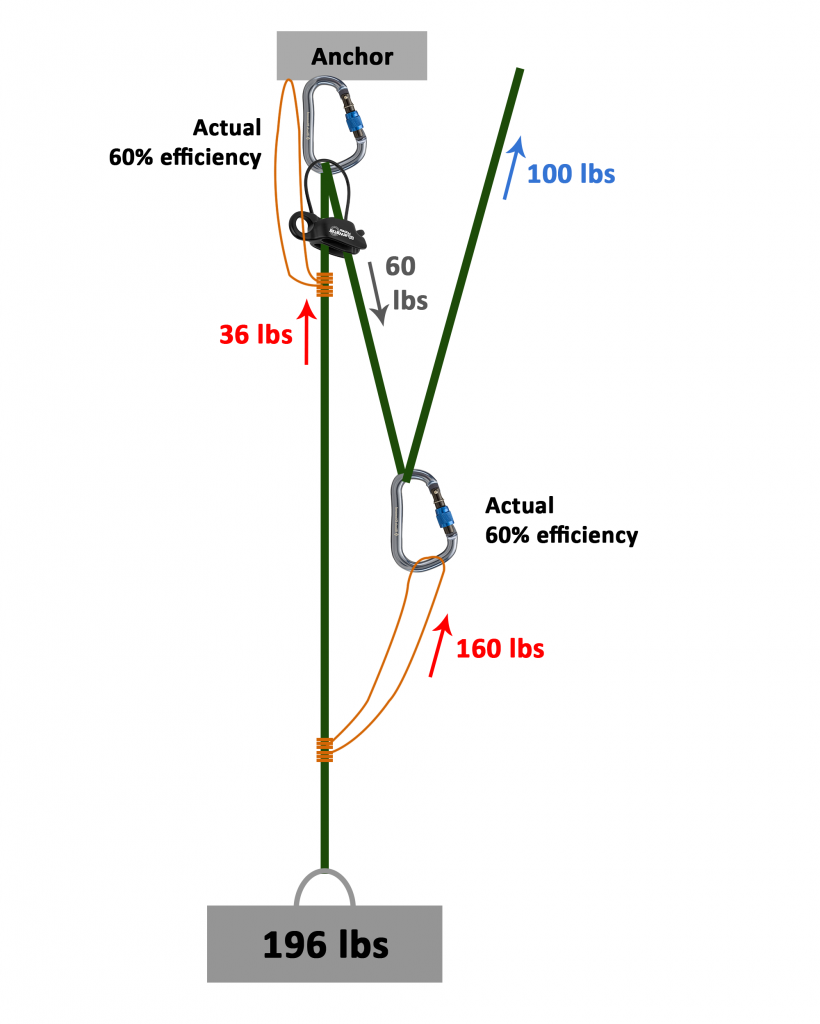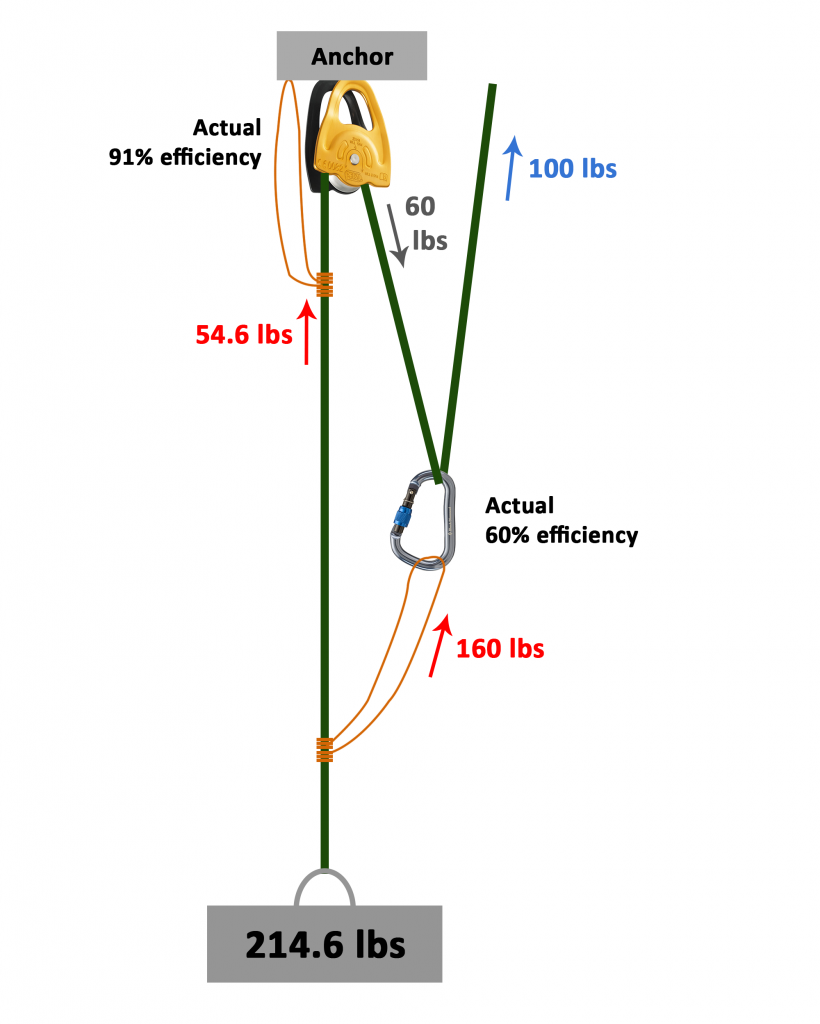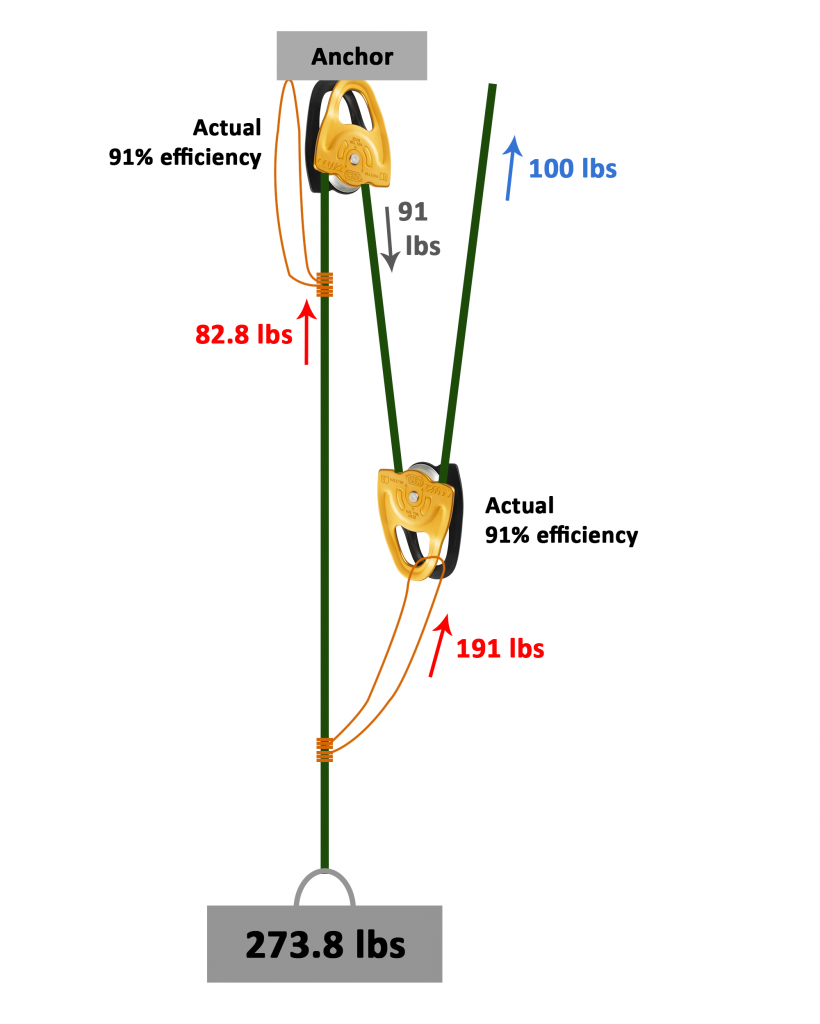A common question when building a 3-1 crevasse rescue system is “If I only have one pulley, where should I place it?”
It seems like many people answer “at the anchor”, since they seem to believe that’s where the most force and friction will be.
Interestingly enough, even many instructors/guides have never done the math behind this decision. Placing the single pulley at the anchor only adds a measly 9% more total pulling force… you end up with a 2.15-to-1 system. For comparison, a system built solely with carabiners ends up being 1.96-to-1. That pulley hardly did anything! If you’re able to input 100 lbs of force pulling the rope, that means you only gain an additional 19 lbs of output force by adding the pulley.
But if you place the pulley at the correct location, down at the hauling prusik, you add an impressive 25% more total pulling force. You end up with a 2.46-to-1 system. Now that’s a noticeable improvement! If you’re inputting that same 100 lbs of force, that means you gain an additional 50 lbs of output force by adding the pulley to the correct location compared to carabiners alone!
There were only a few sources that taught the correct placement of a single pulley, including books Glacier Mountaineering and Freedom of Hills Bible, and this scientific paper from the University of Oregon.
| Only carabiners | 1 pulley at anchor | 1 pulley at hauling prusik | 2 pulleys | |
|---|---|---|---|---|
| Effective ratio | 1.96 : 1 | 2.15 : 1 | 2.46 : 1 | 2.74 : 1 |
| Weight lifted from 100 lbs input force | 196 lbs | 214.6 lbs | 245.6 lbs | 273.8 lbs |
| Additional weight lifted compared to carabiners | +19 lbs | +50 lbs | +78 lbs | |
| Percent increase compared to carabiners | +9% | +25% | +40% | |
| Additional weight lifted compared to previous | +19 lbs | +31 lbs | +28 lbs | |
| Percent increase compared to previous | +9% | +14% | +11% |
Why does the placement make such a dramatic difference? Let’s get into the physics!
First, we need to clarify the numbers we’ll use.
- Pulley efficiency: 91%
- Carabiner efficiency: 60%
Petzl’s MINI pulley has a claimed 91% efficiency. Efficiency of carabiners can be debated, but we’ll assume a value of 60% efficiency. It’s certainly unlikely carabiners are anywhere more than 66% efficient.
Only carabiners
Let’s take a look at a system built using solely carabiners. We’re assuming an input force of 100 lbs on each of these systems.
The first piece of physics the system encounters is the hauling prusik carabiner. This is actually a 2-1 system, which multiplies the force you input by two. However, due to loss of efficiency of the carabiner, your 100 lbs of force only becomes 60 lbs of force on the other side of the rope, which means your final force is 160 lbs (100 lbs + the 60 lbs on the other side of the carabiner).
60 lbs of force is then also transferred through the anchor. The anchor simply serves as a redirection of force, it is NOT providing any mechanical advantage. That section is a simple 1:1. But due to the loss of efficiency, this 60 lbs of force again gets cut down to a measly 36 lbs of force pulling the fallen climber upwards.
So you end up essentially with a 2:1 system due to the carabiners, which only results in 196 lbs of force from your initial 100 lbs. But that’s significantly better than a 2-to-1 alone, which would actually be 1.6-to-1 when carabiner efficiency is factored in!
1 pulley, placed incorrectly
Now let’s add a pulley. But let’s place it where most people think is optimal: at the anchor.
Just like the system we previously inspected, the first element encountered is the 2-1 system on the hauling prusik. Since we still have a carabiner here, this system fails to multiply our force significantly as we saw in the previous example.
The only improvement here is that the measly 60 lbs of force going around the anchor 1-1 redirect now has a pulley on it, so most of that force is preserved resulting in 54.6 lbs of force pulling the fallen climber. We end up with a small improvement of 19 lbs more force.
1 pulley, placed correctly
The key is to minimize loss of efficiency at the points where you have the most mechanical advantage. The only mechanical advantage in the system is at the hauling prusik, since that’s where you have a 2:1 effect.
In this system, when we reach the 2:1, we’re preserving 91% of our force on the other side, which means we output an upwards pull of 191 lbs thanks to the 2:1 nature of the system. In fact, this means that a simple 2:1 system with a pulley is close to as powerful as a 3:1 built with only carabiners which came in at a similar 196 lbs of force!
And on the other side of the rope, 91 lbs of force is transferred and redirected around the anchor back to the climber. However, we lose efficiency here with the carabiner, but since this is just a 1:1 direction redirect, lost efficiency at this location isn’t as significant as lost efficiency on a 2:1 system. We end up with 54.6 lbs of force helping to pull the fallen climber upwards, for a total of 245.6 lbs of force, an improvement of 31 lbs compared to the incorrect pulley, and 50 lbs compared to carabiners alone.
2 pulleys
If you happen to have two pulleys, sweet. However, do note if you end up making your system into a 6:1, you should use both of your pulleys on the respective 2:1 systems and just use a carabiner on the anchor, for the exact same reason as previously described: Maximize the efficiency where mechanical advantage is actually occurring.
The 3:1 with two pulleys gains you some additional strength over just one correctly placed pulley, but it’s not a huge improvement. That’s because the only gain in efficiency is in the 1:1 redirection around the anchor, so you don’t have any multiplications of force, just preservation of your original input force.
You end up being able to pull 274 lbs. That’s a nice additional 28 lbs, but not life-changing.
Holy crap, carabiners are inefficient!!
Yes, they are. However, the inefficiency of carabiners is actually what allows us to rock climb, so this inefficiency should be appreciated!
Think about it… how is it that you’re able to belay someone who is close to twice your body weight, but you can still stop their fall?
Imagine two climbers tied into opposite ends of a rope, hanging from a roof with the middle of the rope going through a carabiner on the roof.
If that carabiner at the top was 100% efficient, this would essentially be a balance scale, and if one person was one pound heavier, that person would start to go down, and the other person would start to go up.
But we know that’s not going to happen. The two climbers are going to stay where they are. That’s because the carabiner is only 60% efficient. The carabiner is adding friction to the system, and you need additional force to overcome that friction and start moving. Specifically, you need to be 67% heavier than the other person to start moving. So if you weigh 135 lbs and your partner weighs 224 lbs, there is scientifically no way for you to catch and stop their fall (unless you add even more friction to the top of the system than the standard carabiner).
So, let’s be thankful that carabiners are inefficient! Otherwise we would have to use something specifically designed to add more friction when climbing!
If I don’t put the pulley at the anchor, the prusik will go through the carabiner?
One reason some might choose to place the pulley at the anchor rather than the hauling 2:1 system is because they want auto-tending of their progress capture prusik. Otherwise the prusik might slide up into the carabiner and mess things up.
But there’s an easy solution to that: Simply put the rope through a belay device as seen in the diagrams above. Belay devices will automatically tend the prusik. And then use your pulley where its efficiency is multiplied.




